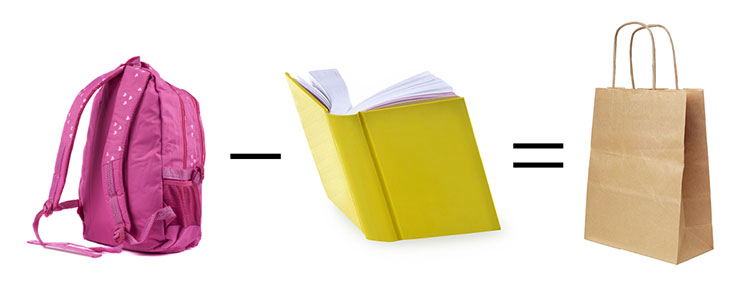D6: Compound Words, Part 4
1. Overview
Hear a two-syllable compound word and identify the last syllable, but without picture clues. Dividing a compound word into individual syllables is called analysis.
“Say bookbag, but don’t say book…”
2. Materials
↑ Top3. Activity
Video: How to play Compound Words, Part 4
You will say a two-syllable compound word from the provided word list, and have the child repeat it. Then ask your child to tell you only the last part of the word you say. There are no picture clues in this version of the game, so he will have to work harder to remember the word and remember the word, divide it into parts. and say only the part you ask him for.
Adult: I’m going to tell you a word. Then I want you to tell me only the last part of the word I say. Here’s the word. Listen: bookbag. Say bookbag. Child: Bookbag. Adult: Now say bookbag, but don’t say book. Child: Um… Adult: Listen: bookbag. Book…bag. Book…bag. Say book…bag without saying book. Child: Bag! Adult: That’s right.Go through the other words in the word list until your child stops paying attention. You can continue the activity at your next session. NOTE: Be careful not to add an extra “the” to your instructions, as in: “Say toolbox without the tool.” The extra word will just confuse your child. Use hand gestures to help your child better understand the activity. Facing the child, extend your two fists in front of you touching each other as you say the compound word. Then put the fist of your RIGHT hand behind you when you tell him to omit the first word of the compound word you say. ↑ Top
4. Confidence Builder
Use the picture cards from Compound Words Part 3. Hold up the picture card and ask the question (e.g., “What’s bookbag without book?”) Then remove the card and repeat the question. The child should answer without looking at the picture. When the child answers correctly, affirm and repeat the answer:Adult: Yes. Bookbag without book is bag. Say that. Child: Bookbag without book is bag.↑ Top
5. Extension
With this extended word list, you can challenge your child with some more words before moving on to the next activity or have a longer word list to use with a group of children. ↑ Top6. Small Groups (2-5 children)
Lesson Objective: With no visual aids, children will hear a spoken two-syllable compound word, delete the first syllable, and say only the last syllable of the word. GELDS (Georgia Early Learning & Development Standards): CLL6.4e Georgia Standards of Excellence: ELAGSEKRF2.b Common Core State Standards: CCSS.ELA-LITERACY.RF.K.2.B Adaptation: Read the main activity, watch the video, and follow the instructions above, with the following changes: Say a compound word, and have children respond by repeating the word while whispering the first syllable. Have the children do this multiple times, whispering the first syllable more and more softly until their whispers can’t be heard and only the last syllable of the word is audible. Give each child several opportunities for responses. Ask the children to look in their homes for compound words. Parents can provide a list to share with the class (bedroom, bathrobe, etc.). To help the children understand that now we are looking for the last part of the word, line the children up in a row and ask, “Who is first? Who is last?” Change the order of the children and repeat. Reinforcement: Have children hold their fists in front of them, side by side, to represent the two parts of the spoken compound word. Have them repeat the compound word. Then have them put the fist that represents the first part of the compound word (their left fist, because we read from left to right) behind their backs and say only the word represented by their remaining (right) fist. Use this Reinforcement at Home form to tell parents and guardians how they can reinforce lessons outside the classroom. ↑ TopLeave a Reply
